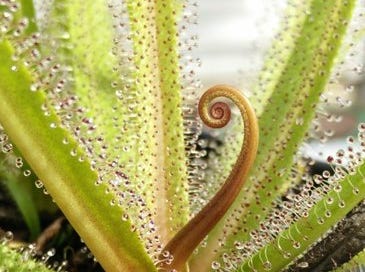CULTIVATION OF DROSERA REGIA
The king sundew has a long history of being tricky, but is it really?
Introduction
To the novice grower scrolling through endless photo threads in hopes of improving their species identification abilities (you know we've all been there), there is little more eye-catching than a well-grown pot of mature D. regia - its common moniker "the King Sundew" is certainly warranted! I too fell into this trap and began to want this species soon after I started growing. However, relatively high online prices and nightmare stories of plants that had died overnight caused me to hold off. Due to a great deal at the NECPS show, I acquired a pot of several small plants and hoped for the best (pictured on the left, now much larger).
I think that lots of people find D. regia to be so frustrating because they try to grow it like their other Drosera. In reality, Drosera regia is only distantly related to other sundews (some people actually believe that it should be separated into its own genus entirely) and has cultivation requirements that closely resemble those of Heliamphora and Highland Nepenthes. Under the correct conditions, this species has actually been very hardy and tolerant for me. Still, being that plants online can sell for close to $40, I wouldn't recommend this species to someone that hasn't grown a decent amount of Drosera already.
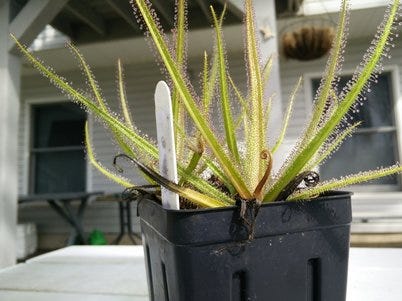
Fertilization
The most foremost difference between D. regia and other sundews is its appreciation for soil fertilization. While soil fertilization isn't necessary, this species has a huge appetite and I've found it much more visually appealing to fertilize through the roots rather than constantly having every single leaf curled up with prey. I use diluted 25% urea-free orchid fertilizer and the plants seem to enjoy it (this is the same concoction that I use on all of my other CPs that like to be fertilized). I definitely wouldn't suggest placing this species in the same tray as other Drosera, since fertilizer leakage will probably lead to dead plants and lots of tears (it's okay, I'm sure you'll find a new D. capensis).
Temperature
I keep my D. regia in my HL terrarium, where temperatures never really get above the upper 70s. Given the origin of this species (fairly high elevations in South Africa), I wouldn't suggest letting temperatures get too high. My nighttime temperatures drop down to the low 60s, which the plants definitely seem to enjoy.I'd imagine that a big drop at night, as well as keeping the roots cool, can help offset daytime conditions that are a tad too hot. Other growers have reported that excessively cold temperatures can trigger dormancy, but, since dormancy isn't required, I maintain the same temperature conditions year-round (which probably isn't very feasible if you grow them in a greenhouse in a temperate climate).
Humidity
I've kept my plants in both the most humid (70%+) and the least humid (around 40%) parts of the terrarium. To be quite honest, they didn't really seem to have a discernible preference. So long as other conditions are favorable, it doesn't seem to me as though humidity is overall a major factor in cultivation success.
Medium & Watering
Like Heliamphora, this species appreciates a well-draining, airy medium. Anything with a decent amount of perlite or sand should be fine. In addition, live Sphagnum can be used as a top dressing to help keep root temperatures low. I water these plants like all of my other Drosera (moist, not excessively wet), and have never had any problems. I've heard of some growers having issues with rot, but I expect that it's completely avoidable if the plants aren't over-watered.
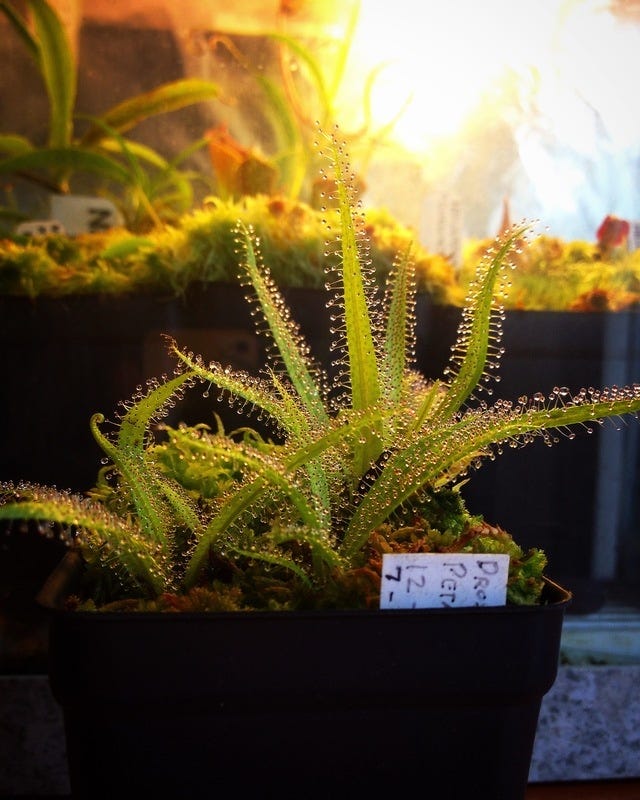
Lighting
Light is pretty self-explanatory. Like pretty much most CPs (with the exception of D. schizandra and maybe a few others), bright light is pretty much a requirement. I keep my plants under T5HOs year-round. This isn't really a species that'll color up too much; even growers that keep their plants under strong, direct natural sunlight may only get significant reddish hues in the tentacles or at the bases of the leaves.
Propagation by Seed
D. regia seed is quite unlike other Drosera seed in that it does not require a magnifying glass in order to view in detail - they are, in fact, quite large! This also means that funny mistakes like dropping an open seed packet will be less likely to make you curse in frustration as with other Drosera seed (not that I've ever done anything like spill packets of seed all over myself, that would be silly!). Sow seeds on the surface of medium that you would grow adult plants in and give them the same conditions that a growing plant would expect. They germinate usually within 2-4 weeks, often quicker than many subtropical Drosera. No stratification or special treatment to induce germination is necessary. After the seedlings have developed a number of true leaves they will need to be heavily and constantly fed.
I apply crushed beta fish food pellets to the leaves and fertilize the plants via the roots with the same concentration of orchid fertilizer I use on Nepenthes and Heliamphora. Other growers prefer Osmocote or satisfy their ghoulish desires by supplying the plants with live insects and watching the leaves dramatically curl over the hapless creature over the course of several hours. It does not matter as long as the plants are getting a suitable amount of nutrients. Some growers report that this species is difficult from seed since their seedlings tend to die after they have developed a number of true leaves. I think that this is likely a result of the seedlings starving to death as I have never had this problem.
Propagation by Root Cuttings
D. regia has thick, fleshy roots that are ideal for root cuttings. If you are ever in a situation where the roots of a healthy plant are exposed (i.e. repotting) and you have the opportunity and desire to lop off a few, taking a few cuttings is an excellent way to get a number of large plants quickly. When I propagated this species from root cuttings in the past I chopped the roots into segments about 1'' long , laid them on the surface of some moist Sphagnum, and covered them with a few sprigs of Sphagnum (enough to keep the cuttings hydrated but still allow light to penetrate through to them). Plantlets started developing from the roots after around 2 weeks for me. Plants from root cuttings will attain a larger size more quickly than plants from seed.
Additionally, if you have a larger plant that is declining in health for some reason, root cuttings may be used as a final resort to propagate it before it croaks as long as there are still healthy roots.
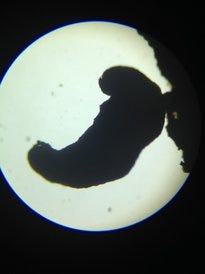
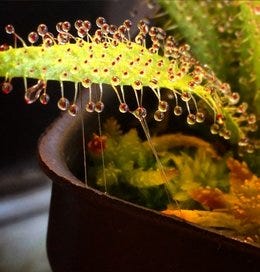
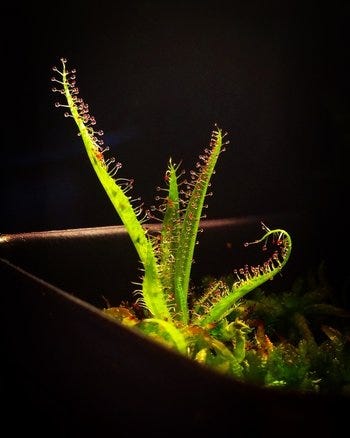
The Big Picture
The overall takeaway from this should be that, given the right conditions (bright light, cool temperatures, airy media), D. regia can actually be a fairly fast-growing and tolerant species. In my opinion, it's definitely one of the best species out there, and anybody contemplating whether or not they should cultivate it should bite the bullet and give it a try - you won't regret it!

